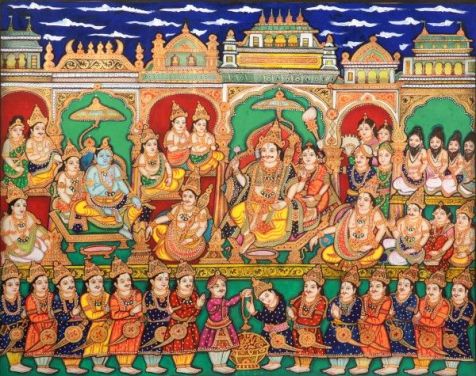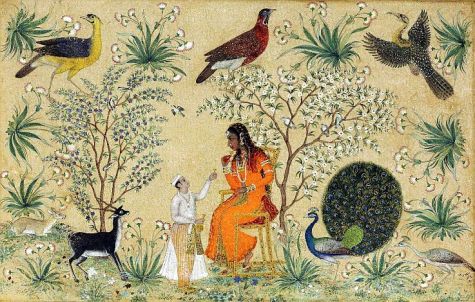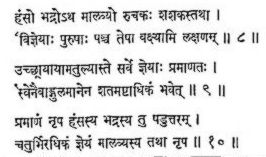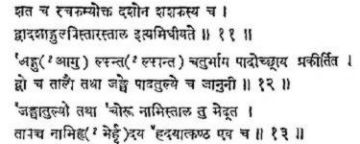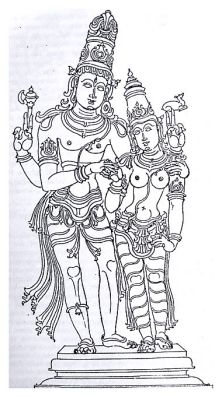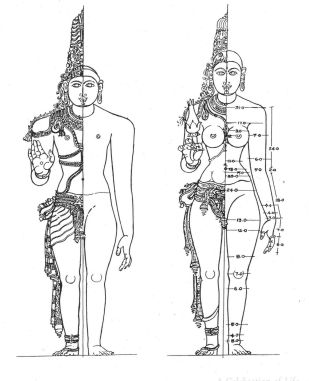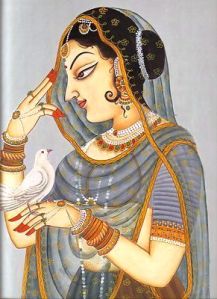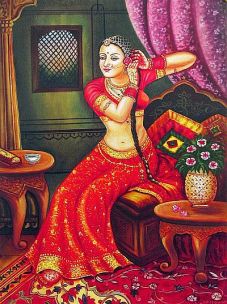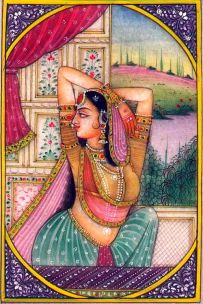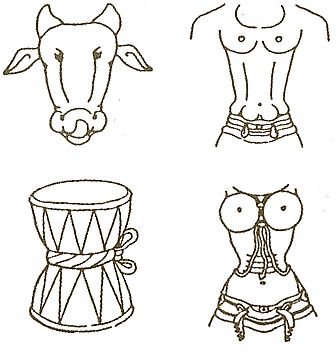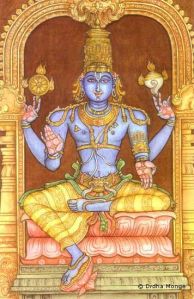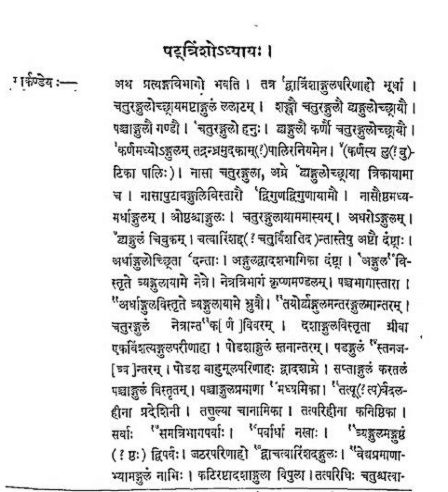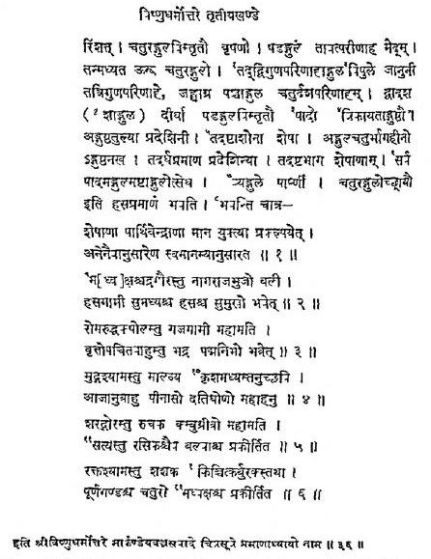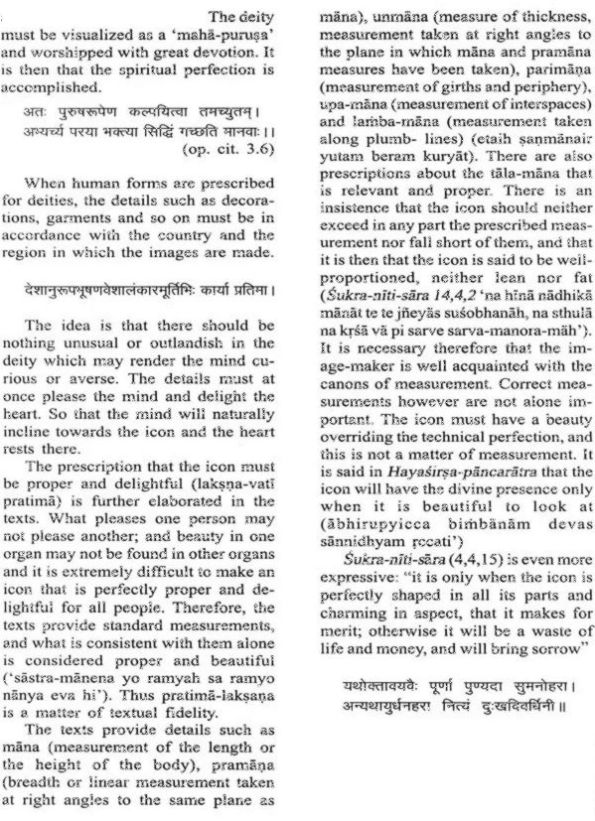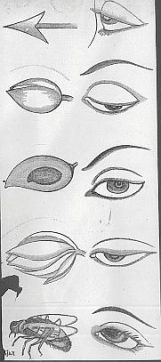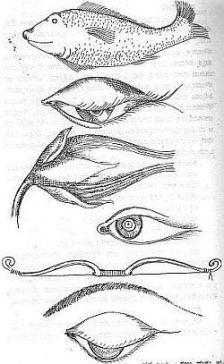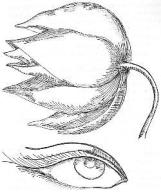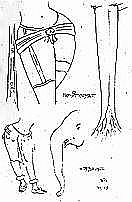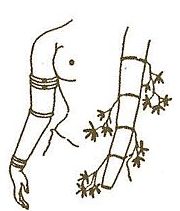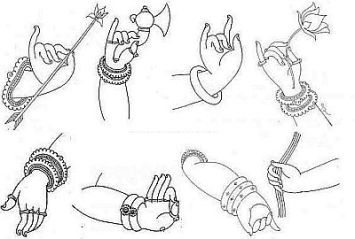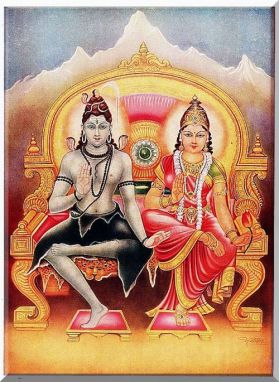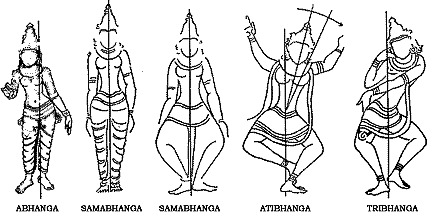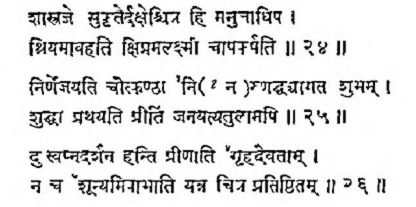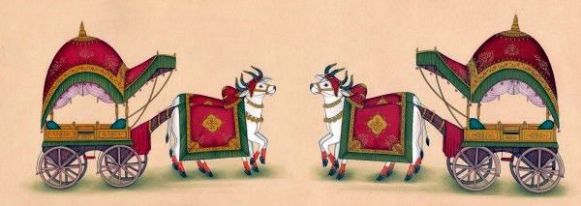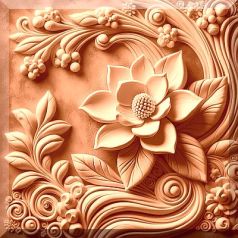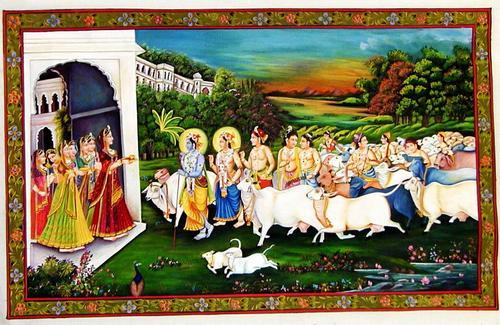[This is the fifth in the series of articles I would be posting on the art of painting in ancient India with particular reference to the Chitrasutra of Vhishnudharmottara purana
The previous (the fourth) article was about colors; the concepts, classifications and application of colors. It also briefly mentions about shading and how to go about drawing.
The current article covers the concepts about depiction of things seen and unseen in the world around us, or rather how the objects in nature could be visualized and personified as if each aspect of it is a living person with a character and attribute of its own.]

20. The abstract and the realistic depiction
20.1. The Chitrasutra, at several places, discusses how the persons and objects that we see in our day to day life, as also the nature that surrounds us could be depicted in art. It adopts a two-pronged approach. It instructs; while the representations of the objects and persons, as drawn on the canvas should bear a credible resemblance to their original, the artist , at the same time, should not restrict himself to just faithful reproduction of forms and appearances, but should try to go beyond “the phenomenal world of separated beings and objects that blind the reality beyond”.
20.2. In other words, it was emphasizing that art was more than photographic reproduction of visible objects. It was about the experience of a person and his expression of it through art; and about his unique creative genius, imagination, enterprise and individuality as an artist .It was not about how the world appears to one and all, but how the artist experiences and visualizes it. Its object is to elicit an emotional response, the viewer’s experience, the rasa.
20.3. These two approaches are not mutually exclusive; they exist side by side on a canvas and complement each other. The abstract and the realistic depiction are thus the two sides of Indian art. The latter is outward looking, and derived through observation; while the other is inspired by emotive perception and visualization of its essence. The two together enrich the aesthetic experience provided by an art work.

21. Realistic depiction of objects
21.1. As regards the realistic depiction of the objects, the text considers it essential to lend credibility to their depictions. The text, therefore, reckons rupa-bheda and sadrushya, among the six essential elements of a painting. Rupa-bheda consists in the knowledge of special characteristics of things – natural or manmade; say, the differences in appearances among many types of men, women or natural objects or other subjects of the painting; while Sadrushya aims to depict, in painting, those distinctions and resemblances.
21.2. The Chitrasutra instructs the resemblances should not merely be general but should extend to details as well. Every part of the object represented should agree with the general treatment of the whole object. It also says that the persons should be painted according to their country; their region, their colour, dress, and general appearances as observed. Having well ascertained the person’s country, region, occupation, age and his status in life; the text says , his other details such as his seat, bed, costume, conveyance, stance, and his gestures should be drawn.
Bhudya rupam yatha-vesham varnam cha manujo-utthama / Deshe-Deshe naraha karyaha yatha-vath samudbhavah /3.42.49/
Desham niyogaha sthanam karma bhudhya cha yatna-thaha / Aasanam-Shayanam-Yanam -Vesham-Karyam Naradhipa /3.42.50/
[The Chitrasutra explores this subject in great depth, detailing the characteristics of persons hailing from various regions and occupations. The text also describes the characteristics of different tribes and castes as distinguished by their complexion; noticeable physical features, costumes and habits. Since it is rather detailed, I have posted it separately. Please check Part four]

22. Drista & Adrista
22.1. The representation of objects as they are seen or observed normally in life, is termed in the text as Drista, meaning in the way the things appear or as they are visible. In contrast to that, the text speaks of Adrista, meaning objects as visualized or personified by the artist, though they might not actually appear as such.
Having made this distinction, the text suggests that the two should together be employed to harmoniously blend the subject and its illustration; the subject and its effect; and the reality and its symbol, in order to provide the painting an expressive language. For instance, while faithfully depicting the details of the subject (say, the hours of day or night, or the seasons), its effect on the nature around and on the persons are also to be symbolically pictured. These help enhancing the quality of depiction of the subject and the artistic eloquence of the painting.
22.2. Hours of day and darkness

The time of the day, morning noon and evening with its approaching darkness are suggested by appropriated indicators.
The daybreak is suggested by the opening of the lotus petals in the pond and the bees swarming around; the farmer with his plow proceeding to his fields
Midday is suggested by the Muni-kumaras clasping their hands in yama-pasa-mudra peeping at the sun through the aperture created by the joining of the fingers.
Evening is suggested by the approaching darkness, lighting of the lamps and return-home of the cows at go-dhuli.
The twilight is also suggested by the roaming on highstreets of courtesans and paramour vita-s, cheta-s and raja-vallabhas.
The Chitrasutra suggest that night may be indicated by the moon, the stars and sparse human movement as also by the lurking or prowling of the thieves in the shadows and of men asleep
Sachandragraha-nakshatram tatha darsita-laukikam / asannaatas-taskarm ratrim darshayet supta-manavam // 3.42.68
In this context, the text, by way of illustrations, enumerates the following suggestions for showing the subject –the hours of darkness:
Evening – by the red glow in the sky, cows and calves retuning home raising a small clouds of dust, Brahmins engaged in their prayers;
Setting in of darkness – by men hurrying back to their homes, the birds flying back to their nest, lamps just beginning to glow;
The first part of the night – by young and eager love struck women walking hurriedly with side glances to meet their lovers;
The night – with moon , planets and stars, thieves lurking in the shadows, men fast asleep; couples amorously engaged;
Moon shine – by kumuda flowers (the type of lotus that bloom at night) in full bloom while many petals of lotus are closed;
Early dawn ending the darkness – by rising sun, street -lamps looking dim and crowing cocks.


[There is an interesting argument going on, alongside, in the text. It argues that the art of sculpting is far more difficult than painting. It says; it is almost not possible to depict, directly, in a sculptural panel the time of the day or night – darkness, evening , twilight or bright light etc.. That difficulty also applies to depiction of colours (colour, in fact , is not a medium directly compatible with sculpting).
And, it is also not easy to bring out the differences between a dead body and a sleeping person, particularly if the two are placed side by side. The sculptor – artist (shilpi) will have to resort to some other clever suggestions to bring out the differences. That depends on the ingenuity of the artist. ]
22.3. The seasons
Similarly, the text describes the characteristics of each of the six seasons as are gathered through keen observation of nature. It says that in general, the seasons should be shown according to their character. It also instructs , the explicit depiction of the nature of each season could be complimented by suggestions and effects of the season on the state, the form and appearance of the trees, flowers, fruits, birds, animals etc looking delighted or otherwise ; as also on the moods and lives of persons.
It is amazing how sincere was the detailed observation; and how close was the author’s involvement with nature. The text suggests showing the ways of depicting in the painting the six seasons (ritu) of the year . Such descriptions also abound in the classic Kavyas .


:- The advent of Spring season (Vasantha ritu) is announced by profusion of flowers, fresh shoots, hum of the bees and the notes of the cuckoos. The fresh blossoms of the Asoka trees excite the amorous lovers with budding sprouts decorating their ears.
And, by merry men and women, vernal trees in bloom, bees swarming about and cuckoos perched on tree branches.
Kusumanjanma tata nava-pallava tadanu shad-pad-kokila-kujitam iti yatha-kraman avirbhun-madhura druma-vatin avatirya vasanthalim (Raghuvamsha 9.26)
Kusumam eva na kevalam artavam navam Asokataros samaradhipam / Kisalayaprasavo pi vilasam madayita dayitasravanarpitah/ ( Raghuvamsha .9.31)
Meghair medhuram ambaram ( Gitagovinda)
:- Summer season (Grishma ritu) – by dried pools, languid men, deer seeking tree shades and buffaloes burrowing in the mud and wallowing in shallow ponds;, diminished water level in the lotus ponds; the moss exposing the length of lotus stalks; the water level in the ponds reaching up only to the hips of the bathing damsels
The fun-loving young women play in the water (jala-krida) – with the decorations on their faces in disarray; the braid unbound; musk painted patterns on their arms washed away; the pearl earrings loosened, the wet silken garments stuck on the hips, with pearl-white waistlines appearing like stars dimmed by moonlight. – Raghuvamsa 16.67.65
The ladies smear their breasts with sandal paste, stroll along the garden in the shade of thick leafy trees among the waterfowls in the cool water channels
Sarpatsarini varistalate vinyasta-pushpa-potkare nirandhre kadalivane guru-dala-achchhayapahatar –katvishi / karpura-guru-panka-pichchhila-ghana-uttunga stanalingibhih kantakelir-ratrair aho sukritibhir madhya-nadinam niyate (Subhashita-ratna-bhandagara)

:- Rainy season (Varsha ritu) – by flashes of lightening, heavily laden clouds, lions and tigers sheltered in caves;
The rainy season with its dark clouds, lightening streaks, long rows of white storks in their picturesque splendor flying low against the backdrop of rain bearing dark clouds is lovingly immortalized in several of Indian poetic works.
The Rainbow on dark clouds stimulate mirth of the peacocks with spread colorful tails dancing as if to celebrate the arrival of cool showers, add luster and grace to beauty of the picture.
In the paintings, the gentle rain is shown by slight vertical dots in white, like scattered pearls, against the darkened sky.
Ghana eva tarala-balike tatid iva pite (Gitagovinda)
Garajabhis satadid-balakas-balair meghais sasalyam manah (Mricchkatika.6.1)
Garbha-dhanakshana-parichayan nunam abaddhamalas sevishyante nayana-subhagam khe bhavantam balakah (Meghaduta .1.10)
Srenibhutah parigananaya nirdisanto balakah (Meghaduta.1.22)
Navambhumattas sikhino nadanit meghame kunda-samana-danti Ghatakarpara/ sukla-apangis sajalanayanais svagataikritya kekah pratyudyatah katham api bhavan gantum asu vyavasayet (Meghaduta.1.23)
:- Autumn (Sharad ritu) – by trees laden with fruits and flowers, earth covered with ripe cornfields, tanks full of water with swans and lotuses;
akampayan phala bhara aanata shaali jaalaan aanartayan taru varaan kusuma avanamraan utphulla pa.nkaja vanaam naliniim vidhunvan yuunaa manaH calayati prasabham nabhasvaan (Ritusamhara.3.10)
:- Dewy season (Hemanta ritu) – by frost on horizon and earth covered by dewdrops; and
nava pravaala udgama sasya ramyaH praphulla lodhraH pari pakva shaaliH viliina padmaH prapatat tuSaaraH hemanta kaalaH samupaagato ayam (Ritusamhara.4.1)
:- Winter season (Shishira ritu) – by horizon shrouded in hoar-frost, shivering men and delighted crows and elephants.
The winter with its blast of cold winds forces one to seek the warmth of the indoors, covering oneself with heavy wraps and enjoying the cheerful company of youthful damsels in front of the crackling fire .
Niruddha-vatatayanam-mandirodare hutasano bhanumato gabhastyah , guruni vasamsyabala sayau-vanah prayanti kaletra janasya sevyatam (Ritusamhara.5.2)


There are classic depictions of other figures as well :
Abhisarika, the beautiful girl, going out, in moonlit night (jyotsni or Shukla), to meet her lover should be in serene white and flowing garments ; and , should be decked in pearls (mukta-abarana-bhushitam) .


And, on other dark nights (Tamasi) she wears blue garments (nilamsu parigraho). And, in either case, she covers her head ; and, she does not wear bangles and anklets to avoid twinkling sounds.
There is even a case of an impetuous young girl , aided by her chamber-maid, eloping with her Lover, riding an elephant (of all the escape vehicles…!!) under the cover of night. She looks anxious and rather scared.

The lovelorn (viraha vyasthaya), lonely maiden in search of lover is to be drawn as pale (vyanjayanti) and emaciated (krisyam) ; her hair in a single braid (eka-veni) is twisted and unkempt .
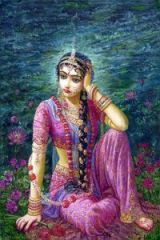


The Proshita-bhartrka whose lover is in distant lands , on war or business, is pining for him. She , in sorrow, has given up applying cosmetics or wearing ornaments and colourful dresses. She has grown lean and pale ; her eyes are constantly searching for her separated lover.
Pregnancy is suggested by pallor in the face, slimness of the body, sparce ornaments and a natural languor.
*
In contrast , Svadhina-bhartrka who enjoys the company of her lover , and loves to dominate him; and, the Vasaka -sajja who is busy tidying up her room in anticipation of meeting her lover , are to be pictured as happy, radiant, light hearted and sportive , wearing their best and joyous dresses .


*
The bridal sarees (vadhu dukulam), generally, have a swan design (kalahamsa lakshanam) on their border. It was a popular design.

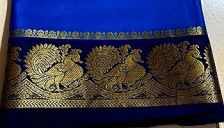

*
The heroic warrior facing his opponent is depicted in the challenging stance of Alidha is a representation (bhava-chitra) of Vira -rasa. His torso is somewhat thrust out, the hair tied up, the front knee is bent back and retracted; and he is ready to attack.


Pratyalidha is used in relation to Alidha-sthana. The strung bow with the arrow in position is pulled back up to the ear; the arrow is about to be discharged; and , he is looking heroic and magnificent.
*
The amalgam of subject and its symbols renders a work of art at once particular and universal. That is the reason the Indian figurative art is not mere portraiture of the specific; but it is a symbol pointing to a larger principle, akin to the finger pointing to the moon.
22.4. Barahmasa
Inspired by the vivid word-pictures portrayed in the Chitrasutra, a school of painting known as Barahmasa (meaning, the twelve-months), flourished during the later periods. Its scenery epitomizes the landscape of the imagination, in Indian painting. This school lovingly captures the delights, the emotions and the enjoyment of the lovers in each of the six seasons. These sublime works of art, which gained fame as iconic representations of the seasons and as metaphors for emotions, have inspired generations of artists, poets and lovers.
The essential theme of the Barahmasa is the passionate yearning of lovelorn hearts, the pangs of separation that each change of season stimulates. Each month bringing a special message to the beloved, every season a special reminder of the joys of love and longing. The nature participates in the world of human emotions and mirrors the lovers’ or singer’s experience of tenderness and pain of love.
The transformations in nature , such as the gentle unfolding of a bud’s petals; or melting of a winter night into dew-drops; or the dark dreadful clouds rending with their roar the sky and the earth and frightening the lovely nayika into the arms of her beloved Nayaka and bursting forth into torrential rains – all become symbolic expressions of the seasons and the state of love of the ardent lovers. The Barahmasa depictions of poetry, music and painting, bind the two confronting worlds, the worlds of man and of nature into one thread.
The Barahmasa pictures do tell a tale; each one narrates an event that illustrates the beauty, love and togetherness in the lives of the lovers. That story is entwined on the splendour of nature that surrounds them, in each season.
Let’s take a quick look at a couple of such picture. The painting associated with rainy season (varsha ritu) ‘the Bhadon’ (Bhardapada masa: August-September) captures the characteristic features and symbols of an evening in Indian monsoon. The lovers relax in the balcony of a beautiful garden-house, enjoying the company of each other, watching the graceful flight of cranes against the background of dark monsoon clouds. And, as the peacock dances and jumps on to a window in the courtyard, there is a sudden roll of thunder and flashes of lightening across the dark clouds. The lady-love is frightened and she clings to her lover in delicate embrace. Yet, she cannot take her eyes away from the spectacular and amazing drama of thunder and lightning being enacted in the skies.

The month of Chaitra (March-April) , in spring (vasanta ritu) is depicted by clear blue sky, water-filled streams and lakes, the bushes adorned with flowers just sprouting and singing birds perched on tree branches. The lady love, dressed in her best, is exhorting her lover to stay at home and enjoy with her the intoxicating delights of Chaitra.


The painting that illustrates the month of Agahana (Agrahayana or Margashira: Nov-Dec), in Hemantha ritu, the early winter, depicts clear skies, the swans migrating from the cold mountains and the lovers standing on the terrace overlooking the river with water-birds floating lazily. The day is neither cold nor warm; it is just comfortable. The lovers are wrapped in light-warm clothing. Peace and tranquillity abounds in nature. The lovers are saying to each other how fortunate we are to be alive and to be together in this lovely evening.


22.5. Ragamala
During the later times, another school , the Ragamala School of paintings too used the descriptions provided in Chitrasutra , of nature, men, women, birds, animals and plants, in each season and blended them with the musical mood of the Raga or its queen the Ragini ; as also with the time of day in which the raga is sung and with the emotional response associated with that time . All these produced a series of most enchanting pictures. Those paintings are a delightful combination of art, music, poetry and a studied, controlled sophistication.


The Ragamala (garland of Ragas) School of painting attempted to translate the emotional appeal of a raga into visual representations. Each raga personified by a colour, mood, the nature surrounding the hero and heroine (nayaka and nayika). It also elucidated the season and the time of day and night in which a particular raga is to be sung. The colours, substance and the mood of the Ragamala personified the overall bhava and context of the Raga. It is a delightful amalgam of art, colour, poetry and music.
One of such pictures is Todi Ragini, a painting associated with Raga Malkauns, as its Ragini. Here, a young woman plays veena as she waits for her lover. But he’s been so long that she gets bored, distracted and a bit apprehensive. As she stops playing the veena and paces restlessly, clutching a flower garland, the deer in the park surround her as if expecting her to continue playing the melody. She’s growing sad, and fears he might not keep his date this evening.

22.6. Landscapes
Continuing on the Drista, the text explains how the subjects associated with landscape paintings; such as: the sky, the hills, dales, trees, etc could be depicted in a painting. Here again the faithful depiction of the subject is to be juxtaposed with its suggestions and its effects, enhancing the artistic expression of the subject. Its scenery epitomizes the landscape of the imagination.
For instance, along with the bright sun, one could depict the images of creatures suffering from heat; and of the flowers and creepers wilting under the hot sun. The shower of rain could be suggested by a person well covered; or running for shelter under a tree. Similarly, along with the full moon the kumuda flower in full bloom could also to be shown. Such artistic suggestions, symbols and effects add to the depth of a painting.
Some of the pictures lovingly capture the delights, the emotions and the enjoyment of the lovers in each of the six seasons. The sense of belonging, togetherness and identity with each other is suggested in a rare and a beautiful painting that shows Radha (highly idealized lady love) and Krishna having exchanged their clothes. It is as if each has entered the other’s soul.

She wears his peacock feather,
He dons her lovely, delicate crown;
She sports his yellow garment,
He wraps himself in her beautiful sari
How charming the very sight of it. . .
The daughter of Vrsabhanu turns Nanda’s son,
And Nanda’s son, Vrsabhanu’s girl.
(Srivasta Goswami, Trans. The Divine Consort, 87)
Elaborating on how the nature in a landscape painting could be depicted, the text suggests:
The sky should be shown without any special colours and full of birds;
A hill – by a cluster of rocks, peaks, trees, creepers, waterfalls;
A forest – by various sorts of trees, birds and beasts;
Water – by fish, tortoise, lotuses and other water plants.
While on the subject of water, King Vajra interjects querying “I cannot wait to ask. Please tell me more about representation of water. What are its true and untrue colors?”
The sage explains “The untrue color of water resembles that of lapis lazuli; that is because of the blue sky reflected in a pool of water. But, the natural color of water is seen in the cascades of a water-fall; its colour resembles moonlight.”
22.7. Cities and village scenes

The text also explains the ways for depicting the atmosphere of a locale.
It suggests showing:
A city by beautiful temples, palaces, shops and royal roads;
Markets- by a variety of merchandise and people busy trading;
Drinking and gambling dens – by men rolling in intoxication; and gamblers without their upper garments-the winners making merry and the losers crestfallen;
Richly caparisoned chariots or carts , be decked in colorful decorative coverings

And, A village by its hedges and sparse gardens; and , its women folk


23. Visualization and personification of deities and objects


23.1. While Elaborating on Adrista, the text says the objects in nature could also be visualized or personified by the artist, endowing its objects with distinct personality. In this respect, the art of painting, the chitra, enjoys a distinct advantage, and a far greater artistic liberty and freedom of expression, as compared to sculpture, the shilpa. A painting can comfortably handle things that are virtually impossible to be shown in sculpture; those things include the color, space or the darkness of the night etc. Painting enjoys the virtue and facility of rendering the absolute in tangible and visual forms.
23.2. In the traditional Indian painting, the ambiguity of color and appearance in its descriptive and suggestive forms was clearly kept apart. Each form of depiction had a purpose and a place of its own; but they often combined to produce a magical effect, bestowing on the Indian art a unique character and vision.
23.3. We therefore see in the work of the ancient painters, subtle nuances as also the representations of the tangible world, the beauty of its forms, its volume and weight; and yet there is always a suggestion of something which is more and beyond.
23.4. The visualization and personification of objects in nature, as envisaged in the Chitrasutra, employs whole sets of symbolism. For instance, the sky when painted in its natural and descriptive context should be painted almost without any color. But, when sky is personified, it should be depicted as noble person, blue-lotus in color, wearing a garment of that color; and carrying sun and moon in his hands.
23.5. The sun in its natural depiction should be bright and shining, lightening up the canvas. But, when personifying the sun, it should be shown as a person with four hands , very lustrous , in the color of vermilion, with all auspicious marks;, with glowing garments; adorned by flower garlands and rich ornaments. His left and right hands should be shown projecting sunbeams, resembling reins of a chariot.

Varaha Mihira, in his masterly encyclopedic work Brhat Samhita (Ca. Sixth Century CE), under the Chapter 58 – Prathima Lakshana Adhyaya– specifies that:
-
- In the image of the Sun, the nose, the forehead, the shanks, the thighs, the cheeks and the breast shall Be large. In adorning the image, the method followed in the northern countries shall be followed. From breast to the feet shall appear covered.
- The Sun shall be represented as holding a lotus in each hand, as wearing a crown and pendants, with garlands hanging from his neck and as surrounded by Devas.
- The face shall be bright as the lotus. The body shall be covered with stitched coats / the countenance shall be cheerful and the luster of the gems shall add beauty to the image. He who fixes in a temple an image of the Sun of the above description will enjoy prosperity.
- An image of only a cubit high is good; one of 2 cubits long will bring on wealth; and if the height be 3 or 4 cubits there will be plenty and prosperity

***
The personified Moon should be made with a white body (as composed of water), in white garments, lustrous, with all ornamental and four hands. In his two hands he should be shown holding two kumuda (night-lotuses) flowers in full bloom .He should be endowed with luster and beauty.

While visualizing and personifying the rivers, they are to be represented as persons having their own character and personality. They have to be given a human shape, and they should be astride their vahana (mount) on bent knees, and holding in their hands a pitcher.
Each river it is said has a distinct personality and character. For instance, the Ganga turbulent and milky in color gushes down the mountain slopes. The Yamuna, in contrast, is of dark hue, placid and wide.

Another name for water in Sanskrit is Apah. The term Apah is invested with varieties of meanings. Apah, the waters are called the mothers (apah asmin matarah) : ‘The waters are our mother (ambayah), womb of the universe’ (RV.1.23.10).Water is the nourishing mother who gives birth to the manifest world. She is the Mother of all creation; and, denotes freedom from bondage. Apah, as rivers is the creative energy which is active and moving Since Apah suggests movement (gati), the life-giving (jiva-nadi) , flowing rivers and streams are deemed feminine (Prakrti) ; while the stagnant Samudra the ocean into which all beings go and from which all beings emerge acquired a masculine identity (Purusha).
Samudra (the Sea) is described as the gatherer of waters; the goal of all rivers; and, the eldest of the rivers (samudra jyestha), The sea is personified as the King of Oceans (Samudra –raja); and, is represented by a noble looking Lord holding afloat in his hands jewel-vessel. The halo around his head should be drawn resembling water.

The person of a mountain symbolized as Parvatha –raja (king of mountains) – the lordly mountain, a sublime shelter for sages, the greatest treasure trove of minerals , giving birth to and sheltering great rivers, cascades, cataracts, and caves– is usually shown as a semi human mountain peak with a halo around his head.
Kama the amorphous desire (cupidity) that drives us and resides in each one of us, too, is personified. The text (Part Three; chapter: 73; verses 1-15) mentions that Kama as one of unrivalled beauty. He should be riding a parrot; and should be carrying a bow and arrow with five arrow-heads. His eyes half closed as if intoxicated and curled smile on his lips. His beautiful four wives Rathi, Priti, Sakhi and Madasakthi should be done extraordinarily charming and bewitching.

24. Rasa
24.1. The artistic creation though not real can arouse in the mind of the viewer, the experience of the original object. The objects in art are virtual and not physical. The artistic experience is, therefore, inferential and indirect; rather than direct perception.
A real work of art, in addition to possessing emotive charge carries a strong sense of suggestion and the potential to produce various meanings. It can communicate through suggestions and evoke layers of meanings and emotion.
Rasa is that experience which the viewer derives from an art expression.
Sage Markandeya said (43- 1-39): The Rasa-s, (emotions) represented in painting are said to be nine, viz., :
-
- Srngara (erotic),
- Hasya (humor, cheer),
- Karuna (pathos),
- Vira (heroic),
- Raudra (ferocious),
- Bhayanaka (horror, frightful),
- Bibhatsa (loathsome),
- Adbhuta (wonder, exotic and supernatural) and
- Shanta (tranquil, peaceful).
Pictures to embellish homes should depict Srngara, Hasya and Shanta rasas. The rest of the Rasas should never be used in the house of anyone where women and children dwell; including the residential quarters of the ruler. But, in the assembly halls of kings, palace of a ruler and in the temple of a god all the sentiments may be represented

24.2. The text says, “Anything be it beautiful or ugly, dignified or despicable, dreadful or of a pleasing appearance, deep or deformed, object or non-object, whatever it be, could be transformed in to rasa by an artist’s imagination and skill”
24.3. The great scholar Abhinavagupta (10th-11th century), remarked, a creation in art is the expression of a feeling that is freed from localized distinctions; it is the generalization of a particular feeling. It comes into being through the creative genius (prathibha) of the artist. And, it finds its fulfilment in the heart of the viewer, who derives ananda the joy of aesthetic experience. He is, therefore, central to that art -experience. That pleasure must not, however, bind the viewer but must liberate him from his limited confines.
24.4. A true aesthetic object, Abhinavagupta declares, not merely stimulates the senses but also ignites the imagination of the viewer. That experience sets the individual free from the confines of place, time and ego (self). Thus, art is not mundane; it is alaukika, beyond the ordinary.
It is that magical quality which the Chitrasutra too was talking about.
***
While on the subject of Rasa, let me mention that The Vishnudharmottara is the earliest text that seeks to elaborate the theory of Rasa in the context of visual arts such as painting.
The Vishnudharmottara and another text the Samarangana-Sutradhara recognise the role of the Natya-Shastra from which they derive and modify their own theories.
At the same time there are also certain differences between the two texts. While the Natya-Shastra mentions only eight Rasas, the Vishnudharmottara accepts and introduces Shantha as the ninth Rasa.
Another main difference is that the Vishnudharmottara considers the “separation from the beloved (Viraha)” as a state that produces Karuna-rasa; whereas the Natya-Shastra clearly states that the Vipra-lambha involves the condition of sticking to hopeful expectation of reunion with the beloved out of yearning and anxiety, and is therefore a case of Srngara -rasa.
As regards the depiction of the Rasas in a painting, the Vishnudharmottara suggests:
For the erotic sentiment (Srngara), the figures should be depicted clad in sophisticated dress and ornaments; and their amorous beauty should be expressed by the exquisite beauty of the lines.
To bring about laughter in the representation of comic sentiment (Hasya), one should portray the hunch-backed; the dwarfs; the things which look somewhat distorted; and , such gestures such as the unnecessary clenching of the fists and so on.
In the case of the tragic sentiment (Karuna), one should paint situations that evoke sympathy such as begging, separation from the beloved, renunciation, ailment and calamity.
To express the wrathful sentiment (Raudra) in a painting, one should depict harshness, agitation, anger, hostility; and, the destruction of property and food. Its effect should be enhanced by display of glinting weapons and armour.
In a painting expressing the heroic sentiment (Vira), there should be a display of nobleness in form of oath taking and pride; the hero should be depicted with a frown and an arrogant expression.
In a painting expressing the terrible sentiment (Bhayanaka), the subject of portrayal should be vile, frightful to look at, fading away in decay and looking contemptible and murderous.
The painting that represents the sentiment of disgust (Bhibhatsa), should disturb the mind of the viewer, because of its terrifying subject matter such as the funeral grounds and the acts of reprehensible violence.
The marvelous sensation (Adbhuta) is conveyed by depicting someone having a wide-eyed look, an expectant face and beads of perspiration.
The representation of the tranquil sentiment (Shanta) consists mainly of ascetics in meditative postures with a band clasping their legs and of any other subject that expresses calmness
**
The element of Rasa is essentially not different from the other constituents of painting. As in other concepts, its exposition involves an expressive technical sophistication that lends scope to introduce the viewer or practitioner into a profound understanding of the meaning of a painting through the appreciation of its depictions; and, thereby, to experience the sentiments expressed in it.
Rasa, therefore, should not be considered as a separate entity from other technical constituents like measurement and proportion, stances and colors. A good painting should be performed with a working knowledge of all of these factors. Without knowing the theory of Rasa our understanding of painting would remain fragmentary and superficial.

25.1 . The Sukraniti Sara remarks: These laws that the Shastras lay down; these fine analysis of what an image should be, are only of limited extent. But, verily, endless are the forms..! No Shastra can ever define, appraise or enumerate all the perfect (Sarvangai sarva-ramyo) works of art.
And , in a similar manner, At the end of Chitrasutra – the treatise dealing with the Rules of Painting, the Sage Markandeya observes :
Oh King…! In this treatise only suggestions are given; for, this subject can never be described in detail even in as many as hundred years. Whatever has not been said here, should be inferred from the rules of dancing (Nrtya), Oh lord of the earth;
Painting is the best of all arts, conducive to Dharma, and emancipation-Kalanaam pravaram-chitram; Dharma-Artha-Kama-Mokshadam.
It is very auspicious (mangaly-parmam-hetu) when placed in a house (griha-prathistitham). As Sumeru is the best of mountains; Garuda is the chief of birds; and, a lord of the earth is the most exalted amongst men, so is painting the best of all arts- Kshitisatha kalanaamiha pravaram chitra-kalpaha .

Sources and References:
I gratefully acknowledge Shri S Rajam’s sublime paintings
And the other paintings from internet
Citrasutra of the Visnudharmottara Purana by Parul Dave Mukherji
Stella Kramrisch: The Vishnudharmottara Part III: A Treatise on Indian Painting and Image-Making; Second Revised and Enlarged Edition; (Calcutta University Press: 1928)
The Painter in Ancient India by Dr. C. Sivaramamurti
Technique of painting prescribed in ancient Indian Texts
http://curiosity-the-key-to-knowledge.blogspot.com/2006/12/technique-of-painting-prescribed-in.html
The “Sarvatobhadra” temple of the Vishnu-dharmottara-purana
https://openaccess.leidenuniv.nl/dspace/bitstream/1887/2668/1/299_022.pdf
http://www.artknowledgenews.com/British_Museum_Masterpieces_Of_Indian.htmlhttp://www.ethnicindiacrafts.com/Indian_paintings/kangra/the_month_of_bhadon_miniature.html
All illustrations are from Internet











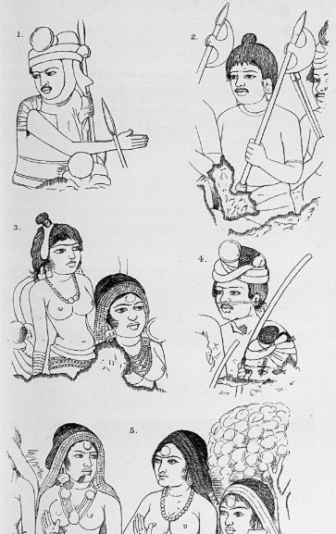
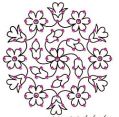





















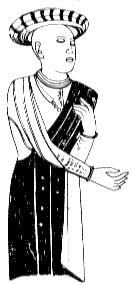


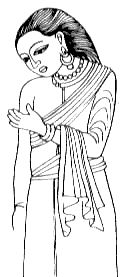

















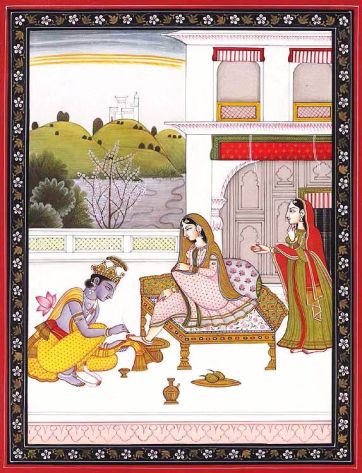
 [A similar tala-mana system of proportions and measures governs the shilpa iconography. Its iconometry prescribes the proportion of the limbs and other parts of its body in relation to its face -length. The Indian artists are governed by proportions than by actual measurements. Thus a figure might look pygmy or colossal while the principles that govern the proportions would be the same.
[A similar tala-mana system of proportions and measures governs the shilpa iconography. Its iconometry prescribes the proportion of the limbs and other parts of its body in relation to its face -length. The Indian artists are governed by proportions than by actual measurements. Thus a figure might look pygmy or colossal while the principles that govern the proportions would be the same.